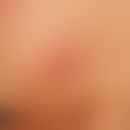Synonym(s)
Keloid blastomycosis; Lobo Disease; Lobo`s disease
HistoryThis section has been translated automatically.
Lobo, 1931
DefinitionThis section has been translated automatically.
Very rare, chronic, deep mycosis of the skin and subcutis with prominent, papular, possibly ulcerative, encrusting, keloid-like nodules.
You might also be interested in
PathogenThis section has been translated automatically.
Loboa loboi; Paracoccidioides loboi; Lacazia loboi; the infection occurs through inoculation in case of small skin injuries or also through insect bites.
Occurrence/EpidemiologyThis section has been translated automatically.
Very rare in Europe. Common disease in tropical rainforest areas of South America, especially in Brazil, Venezuela, Colombia, Central America, Guyana.
LocalizationThis section has been translated automatically.
On uncovered body parts; no mucous membrane infestation, no infestation of the capillitium.
ClinicThis section has been translated automatically.
At the site of inoculation (usually after months) formation of a painless, indurated papule, which slowly develops into a rough, anular or map-like configured, large, bumpy plaque; also formation of confluent nodules. The infection spreads only per continuitatem. There is never lymphogenic or hematogenic spread. All symptoms have the keloid-like aspect, which has led to the name "keloid blastomycosis". The firm consistency of the skin lesions is caused by the densely packed fungal conglomerates in the dermis.
HistologyThis section has been translated automatically.
Epidermis with parakeratotic zones. In the dermis, hypertrophic hyalinized connective tissue bundles and granulomatous infiltrates with numerous yeast-like fungal cells, extracellular and in macrophages are visible. PAS- and Grocott-staining are appropriate.
DiagnosisThis section has been translated automatically.
Travel history, clinic, histology with evidence of yeast-like fungal cells, which can be visualized very well by means of PAS or Grocott staining.
TherapyThis section has been translated automatically.
Excision of isolated skin lesions. Effective chemotherapy is not known. In some patients an improvement was seen under clofazimine (e.g. Lamprene) in combination with itraconazole or 5-fluorouracil.
LiteratureThis section has been translated automatically.
- Burns RA et al (2000) Report of the first human case of lobomycosis in the United States. J Clin Microbiol 38: 1283-1285
- Fischer M et al (2002) Sucessful treatment with clofazimine and itraconazole in a 46 year old patient after 32 years duration of disease. dermatologist 53: 677-681
- Lobo J (1931) Um caso de blastomicose produzido por uma especie nova encontrada em Recife. Rev Med Pernambucana 1: 763-775
- Rodrigez-Toro G (1993) Lobomycosis. Int J Dermatol 32: 324-332
- Taborda PR et al (1999) Lacazia loboi gen. nov., comb. nov., the etiologic agent of lobomycosis. J Clin Microbiol 37: 2031-2033
Outgoing links (6)
Clofazimine; Excision; Fluorouracil; Itraconazole; Keloid (overview); Mycoses, deep;Disclaimer
Please ask your physician for a reliable diagnosis. This website is only meant as a reference.








